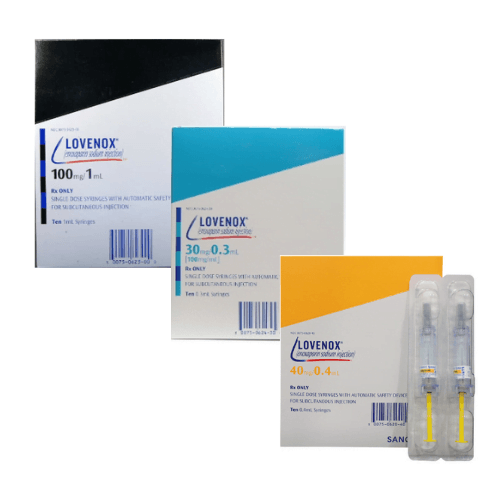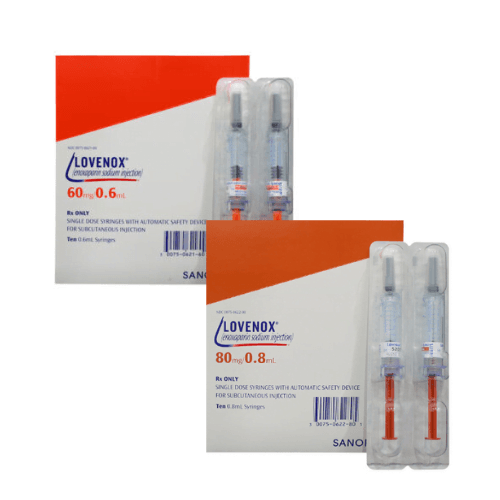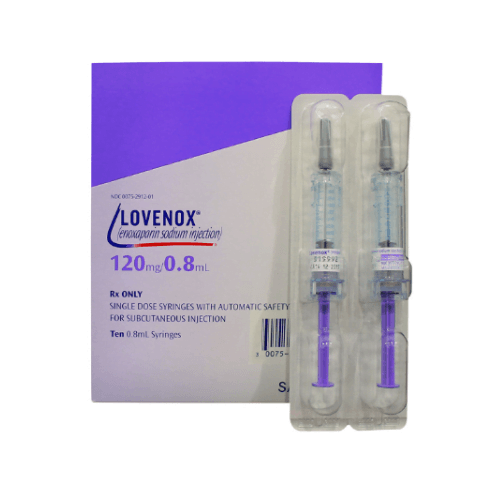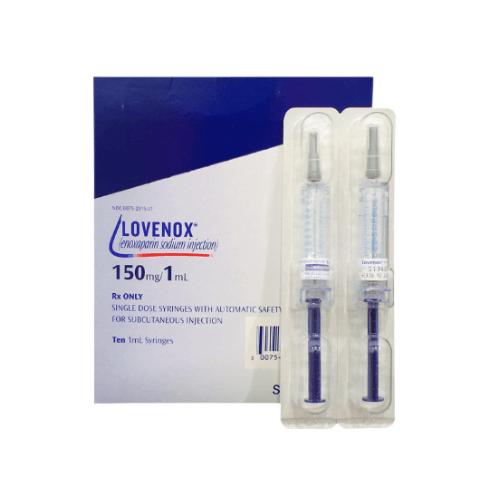Shipping with this method takes 3-5 days
Lovenox® Injections for Deep Vein Thrombosis
Stock up and Save - Get 20% off when you buy 3 or more of any one product. Use code SAVE20 at checkout.
Coupon code cannot be combined with other offers. Sale applies to all products originating from Canada. Maximum allowable quantity equal to a 90 day supply per single order.
Price range: $116.99 through $452.99
Secure Encrypted Payments
Lovenox is a low molecular weight heparin used to help prevent and treat harmful blood clots. It is prescribed after certain surgeries, during hospital stays, or for active clot management in adults. This page explains how the therapy works, who it may suit, key safety points, and how to access it without insurance.
What Lovenox Is and How It Works
YouDrugstore is a licensed Canadian pharmacy in Manitoba. Pharmacists review prescriptions before dispensing.
Acute Coronary Syndrome care and clot prevention often rely on low molecular weight heparins. Lovenox® contains enoxaparin, which enhances antithrombin activity to reduce factor Xa, lowering the blood’s tendency to form clots. Many patients receive Enoxaparin sodium injections in hospital or at home with guidance from a clinician. It is given into the fatty layer under the skin, not into muscle. The treatment has a predictable effect compared with unfractionated heparin, but bleeding risk still exists, so follow your prescriber’s instructions closely.
Who It’s For
This medicine is used for the prevention and treatment of deep vein thrombosis and pulmonary embolism. It is also used in certain heart conditions, including unstable angina and non-Q-wave myocardial infarction. Labelled Enoxaparin sodium injection uses include surgical prophylaxis and inpatient medical prophylaxis where clot risk is high. People with active bleeding, a history of heparin-induced thrombocytopenia, or severe uncontrolled hypertension should generally avoid it. Those with kidney problems, low body weight, or older age may require closer monitoring. Discuss pregnancy and breastfeeding considerations with your prescriber.
Dosage and Usage
Typical schedules differ for prevention versus treatment. Many prevention regimens use once-daily dosing, while treatment often uses twice-daily dosing under medical direction. Use a new Lovenox injection syringe for each dose. Inject into the abdomen at least two inches away from the navel, alternating sides and sites each time. Pinch the skin fold during insertion, insert at the advised angle, and inject slowly. Do not rub the area after the injection, as this can increase bruising. If your clinician shows a different technique, follow their instructions and the official label.
General administration tips:
- Wash hands and prepare a clean surface before handling a syringe.
- Check the solution; do not use if cloudy, discolored, or containing particles.
- Expel large air bubbles only if directed; many prefilled syringes are designed to keep a small bubble.
- Rotate injection sites with each dose to reduce local reactions.
- Record the time and site after each use to support consistent routines.
Strengths and Forms
Enoxaparin is supplied as sterile, prefilled syringes for subcutaneous use. Common presentations include adult prophylaxis and treatment sizes such as 40 mg/0.4 mL and 80 mg/0.8 mL. Product availability may vary by manufacturer and lot. Always match the prescribed presentation and syringe size on your label.
Missed Dose and Timing
If you miss a dose, take it as soon as you remember unless it is almost time for the next one. Do not double the next scheduled dose. If you miss more than one dose, contact your healthcare professional for guidance. Patients using a Lovenox blood thinner injection should keep a written schedule or set reminders to support adherence. Try to inject at the same time each day for consistent effect.
Storage and Travel Basics
Store syringes at room temperature in original packaging to protect from light. Keep them dry, away from excess heat, and out of reach of children and pets. Do not freeze or expose to extreme temperatures. When traveling, carry your prescription-labeled syringes in hand luggage, along with alcohol swabs and a travel-size sharps container. Allow extra time for security screening and keep doses on your person rather than in checked baggage. If you will cross time zones, ask your prescriber or pharmacist for a simple timing plan that fits your schedule.
Pen Handling and Sharps Disposal
These are syringes, not an auto-injector pen. Prepare the skin with an alcohol swab and let it dry. Pinch a skin fold on the abdomen, insert the needle as instructed, inject steadily, then withdraw and release the skin. Do not massage the site. If you see a drop of blood, apply gentle pressure with gauze. For Lovenox subcutaneous injection use, place the used syringe directly into a puncture-resistant sharps container. Do not recap needles. Follow local rules for sharps disposal through a pharmacy or municipal program.
Benefits
This therapy helps reduce the risk of dangerous clots forming in the legs or lungs when risk is elevated. It can be administered at home in many cases, which may reduce hospital time. Prefilled syringes simplify preparation. Predictable pharmacology allows fixed dosing strategies in many scenarios per the label. Some patients transition to an oral agent later, but others may continue the injection course as directed by their prescriber.
Side Effects and Safety
- Common: bruising at the injection site, mild pain, redness, small lumps
- Other: nosebleeds, bleeding gums, heavier menstrual bleeding, easy bruising
- Lab changes: low platelets, mild liver enzyme elevations
Serious risks include major bleeding and spinal or epidural hematomas, especially with neuraxial anesthesia or spinal puncture. Heparin-induced thrombocytopenia can occur. Seek urgent care for signs of significant bleeding, black stools, sudden severe headache, chest pain, shortness of breath, or limb swelling. People with kidney impairment, recent brain or eye surgery, stomach ulcers, or uncontrolled hypertension need careful assessment before starting therapy.
Drug Interactions and Cautions
Medicines that increase bleeding risk can interact. These include other anticoagulants, antiplatelet drugs, NSAIDs, and some antidepressants such as SSRIs and SNRIs. Herbal supplements like ginkgo or high-dose fish oil may also increase bleeding tendency. Inform your prescriber about all medicines and supplements. Extra caution is needed around spinal or epidural procedures. Older adults and people with low body weight or reduced kidney function may require closer observation.
What to Expect Over Time
Many patients do not feel immediate effects. The benefit is risk reduction for new or extending clots while your condition is managed. Minor bruising at injection sites can occur and often improves with rotation and gentle technique. Your clinician may check platelet counts and clinical signs to evaluate safety. If you transition to an oral agent, your team will explain the overlap plan based on the official label.
Compare With Alternatives
Some patients may be prescribed a generic enoxaparin product such as Inclunox Hp. Others may be candidates for an oral factor Xa inhibitor like Lixiana, depending on the condition and clinical factors. Your prescriber will choose the most appropriate therapy, considering kidney function, procedure plans, and bleeding risk.
Pricing and Access
We offer Canadian pricing with transparent checkout for US residents. Many patients pay cash for short courses and want to understand Enoxaparin injection cost before ordering. Review the product page for current options, and compare with your local pharmacy. If you are seeking coupons, see our seasonal offers on Promotions. Orders Ships from Canada to US with tracking. Your payment details are protected with encrypted checkout.
Availability and Substitutions
Supply can vary. If your prescribed presentation is unavailable, your prescriber may consider a therapeutically equivalent enoxaparin product or a different anticoagulant. Do not substitute on your own. Pharmacy staff can coordinate with your healthcare professional if a switch is considered necessary.
Patient Suitability and Cost-Saving Tips
This therapy may suit adults at increased risk of clots due to surgery, immobility, or specific cardiac conditions. It may not suit those with active bleeding, severe thrombocytopenia, or a history of immune-mediated heparin reactions. To reduce the Cost of enoxaparin injection, ask your prescriber whether multi-week supplies fit your course so you can consolidate fulfillment. Set reminders for reorders to avoid gaps. Review the Cardiovascular category to see related therapies that may be part of your care plan.
Questions to Ask Your Clinician
- My risks: what makes me a candidate for this therapy now
- Dose schedule: how many times daily and for how long
- Procedures: what to do before dental work or surgery
- Bleeding signs: which symptoms need urgent care
- Monitoring: whether I need lab checks and when
- Transition plan: if and when I might switch to an oral agent
Authoritative Sources
FDA DailyMed and Sanofi publish official labeling and safety communications. You may also review Health Canada DPD listings for product monographs.
Learn more about clot prevention and options in our articles: Anticoagulant Drugs and Anticoagulant Types. You can also explore condition guides for Blood Clot DVT PE.
Ready to proceed? You can order with prompt, express shipping and US shipping from Canada. Temperature-controlled handling when required.
Disclaimer: This page is informational and not a substitute for professional medical advice. Always follow your prescriber’s instructions and the official product label.
Express Shipping - from $25.00
Prices:
- Dry-Packed Products $25.00
- Cold-Packed Products $35.00
Shipping Countries:
- United States (all contiguous states**)
- Worldwide (excludes some countries***)
Standard Shipping - $15.00
Shipping with this method takes 5-10 days
Prices:
- Dry-Packed Products $15.00
- Not available for Cold-Packed products
Shipping Countries:
- United States (all contiguous states**)
- Worldwide (excludes some countries***)
How is enoxaparin different from heparin?
Enoxaparin is a low molecular weight heparin with a more predictable anticoagulant effect than unfractionated heparin. It primarily inhibits factor Xa via antithrombin, allowing fixed dosing strategies for many indications without routine aPTT monitoring. Unfractionated heparin often requires continuous infusions and frequent lab checks. Enoxaparin is given by subcutaneous injection, while unfractionated heparin can be given intravenously or subcutaneously. Choice depends on the indication, bleeding risk, kidney function, and the setting of care.
Can I use this treatment with an epidural catheter?
There is a known risk of spinal or epidural hematomas when anticoagulants are used with neuraxial anesthesia or spinal puncture. Timing of doses around catheter placement or removal is important to reduce risk. Your anesthesiologist and prescriber should coordinate the plan. Report any back pain, numbness, weakness, or bladder or bowel changes immediately. Follow the official label and your clinician’s timing guidance for procedures involving the spine.
What monitoring is typically recommended?
Many courses do not require routine anti-Xa testing. However, clinicians may monitor platelet counts to screen for heparin-induced thrombocytopenia, watch for signs of bleeding, and check kidney function if needed. In certain populations, such as people with renal impairment, pregnancy, obesity, or low body weight, anti-Xa levels may be considered. Follow your prescriber’s plan and report any unusual bleeding, black stools, or persistent injection-site issues.
Where should I inject the dose?
Most patients inject into the abdomen, at least two inches away from the navel. Rotate sites to reduce irritation and bruising. Clean the skin with an alcohol swab and let it dry. Pinch a fold of skin, insert the needle as instructed, inject slowly, and avoid rubbing the site afterwards. Your clinician or pharmacist can demonstrate the technique and provide site rotation tips.
What if I see bruising or small lumps?
Mild bruising, tenderness, or small nodules at the injection site can occur. These usually improve with site rotation, gentle technique, and avoiding rubbing after the injection. Use a steady, slow injection and keep the needle in place for a moment before withdrawing. If bruising becomes extensive, if you see blood in urine or stool, or if you have persistent pain or swelling, contact your healthcare professional promptly.
How long is therapy usually continued?
Duration depends on the reason for treatment. After some surgeries, prophylaxis may last for days to weeks. Treatment of a confirmed deep vein thrombosis or pulmonary embolism may continue for a longer period and can involve a transition to an oral anticoagulant. Your prescriber will determine the total course based on your condition, risk factors, and response to therapy.
Can older adults use enoxaparin safely?
Older adults can benefit from anticoagulation, but they may have higher bleeding risk and reduced kidney function. Clinicians weigh risks and benefits, consider dose adjustments per the label, and monitor more closely. Report any falls, head injuries, or signs of bleeding right away. Review all medicines, including over-the-counter agents and supplements, for potential interactions that could increase bleeding risk.



